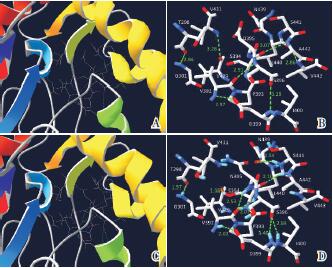 PDF(3935 KB)
PDF(3935 KB)


首例非白人婴儿肝衰竭综合征1型患儿临床特点和分子诊断研究
林伟霞, 郑琪琪, 郭丽, 程映, 宋元宗
中国当代儿科杂志 ›› 2017, Vol. 19 ›› Issue (8) : 913-920.
 PDF(3935 KB)
PDF(3935 KB)
 PDF(3935 KB)
PDF(3935 KB)
首例非白人婴儿肝衰竭综合征1型患儿临床特点和分子诊断研究
Clinical feature and molecular diagnostic analysis of the first non-caucasian child with infantile liver failure syndrome type 1
婴儿肝衰竭综合征1型(ILFS1)是一种由胞质亮氨酰-tRNA合成酶基因(LARS)突变所导致的常染色体隐性遗传病。本研究报道首例非白人ILFS1患者的临床特点和分子诊断经过,为ILFS1的诊治提供参考。患者为2岁9个月男孩,因发现肝脾肿大1年余就诊。1岁5个月时发现肝脾大,实验室检查发现丙氨酸氨基转移酶和门冬氨酸氨基转移酶偏高、低蛋白血症、凝血功能异常和贫血,肝脏病理提示肝硬化和脂肪肝;SLC25A13基因高频突变筛查和一代测序分析仅检测到一个父源性突变c.1658G > A,cDNA克隆分析也未发现母源性SLC25A13等位基因异常转录子;代谢性肝病相关基因外显子组捕获二代测序在患儿LARS基因检出父源性突变c.2133_2135del (p.L712del)和母源性突变c.1183G > A (p.D395N),经一代测序验证,最终确诊为ILFS1。目前随访至4岁,肝功能正常,无贫血,仍有低蛋白血症。
Infantile liver failure syndrome type 1 (ILFS1) is a Mendelian disease due to biallelic mutations in the cytoplasmic leucyl-tRNA synthetase gene (LARS). This study aimed to report the clinical and molecular features of the first non-caucasian ILFS1 patient, providing reliable evidences for the definite diagnosis of ILFS1. The 2 years and 9 months old male patient was referred to the hospital with hepatosplenomegaly over 1 year. At age 17 months, he was found to have hepatosplenomegaly and anemia. Since then, he had been managed in different hospitals. The laboratory tests showed liver dysfunction, hypoproteinemia, coagulopathy and anemia, along with histologically-confirmed cirrhosis and fatty liver; however, the etiology remained undetermined. The subsequent SLC25A13 mutation analysis by means of prevalent mutation screening and Sanger sequencing only revealed a paternally-inherited mutation c.1658G > A, and no aberrant SLC25A13 transcripts could be detected from the maternal allele on cDNA cloning analysis, ruling out the possibility of citrin deficiency. Further target exome high-throughout sequencing of genes relevant to genetic liver diseases detected a paternal c.2133_2135del (p.L712del) and a maternal c.1183G > A (p.D395N) mutation in LARS gene. This finding was then confirmed by Sanger sequencing, and ILFS1 was thus definitely diagnosed. The child has been followed up till age 4 years, and his condition became stabilized.

婴儿肝衰综合征1型 / LARS基因 / SLC25A13基因 / 二代测序
Infantile liver failure syndrome type 1 / LARS gene / SLC25A13gene / Next generation sequencing
[1] Casey JP, McGettigan P, Lynam-Lennon N, et al. Identification of a mutation in LARS as a novel cause of infantile hepatopathy[J]. Mol Genet Metab, 2012, 106 (3): 351-358.
[2] Casey JP, Slattery S, Cotter M, et al. Clinical and genetic characterisation of infantile liver failure syndrome type 1, due to recessive mutations in LARS[J]. J Inherit Metab Dis, 2015, 38 (6): 1085-1092.
[3] Ling C, Yao YN, Zheng YG, et al. The C-terminal appended domain of humancytosolic leucyl-tRNA synthetase is indispensable in its interactionwith arginyl-tRNA synthetase in the multi-tRNA synthetase complex[J]. J Biol Chem, 2005, 280 (41): 34755-34763.
[4] Cusack S, Yaremchuk A, Tukalo M. The 2 Å crystal structure of leucyl-tRNA synthetase and itscomplex with a leucyl-adenylate analogue[J]. EMBO J, 2000, 19 (10): 2351-2361.
[5] Ibba M, Soll D. Aminoacyl-tRNA synthesis[J]. Annu Rev Biochem, 2000, 69: 617-650.
[6] Hu QH, Huang Q, Wang ED. Crucial role of the C-terminal domain of Mycobacterium tuberculosis leucyl-tRNA synthetase in aminoacylation and editing[J]. Nucleic Acids Res, 2013, 41 (3): 1859-1872.
[7] Yan W, Ye Q, Tan M, et al. Modulation of aminoacylation and editing properties of leucyl-tRNA synthetase by a conserved structural module[J]. J Biol Chem, 2015, 290 (19): 12256-12267.
[8] 宋元宗, 牛饲美晴, 盛建胜, 等. Citrin缺陷导致的新生儿肝内胆汁淤积症家系SLC25A13基因突变研究[J]. 中华儿科杂志, 2007, 45 (6): 408-412.
[9] Lu YB, Kobayashi K, Ushikai M, et al. Frequency and distribution in East Asia of 12 mutations identified in the SLC25A13 gene of Japanese patients with citrin deficiency[J]. J Hum Genet, 2005, 50 (7): 338-346.
[10] Tabata A, Sheng JS, Ushikai M, et al. Identification of 13 novel mutations including a retrotransposal insertion in SLC25A13 gene and frequency of 30 mutations found in patients with citrin deficiency[J]. J Hum Genet, 2008, 53 (6): 534-545.
[11] Kobayashi K, Sinasac DS, Iijima M, et al. The gene mutated in adult-onset type Ⅱ citrullinaemia encodes a putative mitochondrial carrier protein[J]. Nat Genet, 1999, 22 (2): 159-163.
[12] Yasuda T, Yamaguchi N, Kobayashi K, et al. Identification of two novel mutations in the SLC25A13 gene and detection of seven mutations in 102 patients with adult-onset type Ⅱ citrullinemia[J]. Hum Genet, 2000, 107 (6): 537-545.
[13] Yamaguchi N, Kobayashi K, Yasuda T, et al. Screening of SLC25A13 mutations in early and late onset patients with citrin deficiency and in the Japanese population: Identification of two novel mutations and establishment of multiple DNA diagnosis methods for nine mutations[J]. Hum Mutat, 2002, 19 (2): 122-130.
[14] Zhang ZH, Lin WX, Deng M, et al. Molecular analysis of SLC25A13 gene in human peripheral blood lymphocytes: Marked transcript diversity, and the feasibility of cDNA cloning as a diagnostic tool for citrin deficiency[J]. Gene, 2012, 511 (2): 227-234.
[15] Seiradake E, Mao W, Hernandez V, et al. Crystal structures of the human and fungal cytosolic leucyl-tRNA synthetase editing domains: A structural basis for the rational design of antifungal benzoxaboroles[J]. J Mol Biol, 2009, 390 (2): 196-207.
[16] Fukunaga R, Yokoyama S. Aminoacylation complex structures of leucyl-tRNA synthetase and tRNALeu reveal two modes of discriminator-base recognition[J]. Nat Struct Mol Biol, 2005, 12 (10): 915-922.
[17] Kobayashi K, Saheki T, Song YZ. Citrin deficiency[M/OL]//Pagon RA, Adam MP, Ardinger HH, et al. GeneReviews. Seattle (WA): University of Washington, Seattle: 1993-2017. 2005 Sep 16 [updated 2014 Jul 31].
[18] Song YZ, Zhang ZH, Lin WX, et al. SLC25A13 gene analysis in Citrin deficiency: Sixteen novel mutations in east Asian patients, and the mutation distribution in a large pediatric cohort in China[J]. PLoS One, 2013, 8 (9): e74544.
[19] Burbaum JJ, Schimmel P. Structural relationships and the classification of aminoacyl-tRNA synthetases[J]. J Biol Chem, 1991, 266 (26): 16965-16968.
[20] Chen X, Ma JJ, Tan M, et al. Modular pathways for editing non-cognate amino acids by human cytoplasmic leucyl-tRNA synthetase[J]. Nucleic Acids Res, 2011, 39 (1): 235-247.
[21] Pang YL, Martinis SA. A paradigm shift for the amino acid editing mechanism of human cytoplasmic leucyl-tRNA synthetase[J]. Biochemistry, 2009, 48 (38): 8958-8964.
[22] Han JM, Jeong SJ, Park MC, et al. Leucyl-tRNA synthetase is an intracellular leucine sensor for the mTORC1-signaling pathway[J]. Cell, 2012, 149 (2): 410-424.
[23] Umemura A, Park EJ, Taniguchi K, et al. Liver damage, inflammation, and enhanced tumorigenesis after persistent mTORC1 inhibition[J]. Cell Metab, 2014, 20 (1): 133-144.